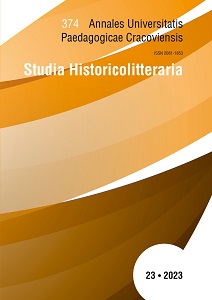Obrazy władców i szlachty polskiej w prozie historycznej Romana Iwanyczuka
The images of Polish rulers and nobility in Roman Iwanyczuk’s historical prose
Author(s): Anna Choma‑SuwałaSubject(s): Studies of Literature, Ethnohistory, Social history, Modern Age, Polish Literature, 15th Century
Published by: Wydawnictwo Uniwersytetu Komisji Edukacji Narodowej w Krakowie
Keywords: Roman Iwanyczuk; Ukrainian historical novel; stereotype; motif; image; Polish historical figures;
Summary/Abstract: The topic of the article is the image of Polish kings and nobility in Roman Iwanyczuk’s historical prose. The analysis was conducted on the basis of three works written at the turn of the 1970s and 1980s. They are only a fragment of the rich literary heritage of the famous Ukrainian novelist. Ciemnoczerwone wino (Черлене вино) takes the reader to the 15th century, to Galicia Volhynia, which was threatened with polonization. Manuskrypt z ulicy Ruskiej (Манускрипт з вулиці Руської) shows the origin of the idea of the liberation war, the future Chmielnicki Uprising, in Lviv at the turn of the 16th and 18th century. The novel Woda z kamienia (Вода з каменю) presents the beginnings of the Ukrainian national revival in Galicia and the history of the Ruthenian Trinity, with its leader Markian Szaszkewicz. The cyclicality and connections between novels, gives Iwanyczuk’s work spatiotemporal continuity, which encompasses, above all, historical events and figures. The analyzed works present a clearly negative image of the representatives of Polish society, which results from the stereotypical approach to the perception of a Pole in the 20th century Ukrainian literature. Polish rulers and nobility are portrayed through the prism of Polish Ukrainian relations at socio political, religious and ideological level.
Journal: Annales Universitatis Paedagogicae Cracoviensis. Studia Historicolitteraria
- Issue Year: 2023
- Issue No: 23
- Page Range: 277-296
- Page Count: 20
- Language: Polish

